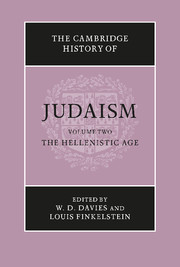Book contents
- Frontmatter
- 1 The archeology of Hellenistic Palestine
- 2 The political and social History of Palestine from Alexander to Antiochus III (333–187 B.C.E.)
- 3 Hebrew, Aramaic and Greek in the Hellenistic age
- 4 The Diaspora in the Hellenistic age
- 5 The interpenetration of Judaism and Hellenism in the pre-Maccabean period
- 6 The men of the Great Synagogue (circa 400–170 .b.c.e.)
- 7 Pharisaic leadership after the Great Synagogue (170 B.C.E.–135 C.E.)
- 8 Antiochus IV
- 9 The Hasmonean revolt and the Hasmonean dynasty
- 10 Jewish literature in Hebrew and Aramaic in the Greek era
- 11 Jewish–Greek literature of the Greek period
- 12 The Apocrypha and Pseudepigrapha of the Hellenistic period
- 13 The book of Daniel
- 14 The matrix of apocalyptic
- 15 The Septuagint and its Hebrew text
- 16 The Targumim
- 17 The Samaritans
- 18 The growth of anti-Judaism or the Greek attitude towards the Jews
- Bibliographies
- Chronological table
- Index
- References
7 - Pharisaic leadership after the Great Synagogue (170 B.C.E.–135 C.E.)
Published online by Cambridge University Press: 28 March 2008
- Frontmatter
- 1 The archeology of Hellenistic Palestine
- 2 The political and social History of Palestine from Alexander to Antiochus III (333–187 B.C.E.)
- 3 Hebrew, Aramaic and Greek in the Hellenistic age
- 4 The Diaspora in the Hellenistic age
- 5 The interpenetration of Judaism and Hellenism in the pre-Maccabean period
- 6 The men of the Great Synagogue (circa 400–170 .b.c.e.)
- 7 Pharisaic leadership after the Great Synagogue (170 B.C.E.–135 C.E.)
- 8 Antiochus IV
- 9 The Hasmonean revolt and the Hasmonean dynasty
- 10 Jewish literature in Hebrew and Aramaic in the Greek era
- 11 Jewish–Greek literature of the Greek period
- 12 The Apocrypha and Pseudepigrapha of the Hellenistic period
- 13 The book of Daniel
- 14 The matrix of apocalyptic
- 15 The Septuagint and its Hebrew text
- 16 The Targumim
- 17 The Samaritans
- 18 The growth of anti-Judaism or the Greek attitude towards the Jews
- Bibliographies
- Chronological table
- Index
- References
Summary
The purpose of this chapter is to show that, contrary to the almost universally accepted view, there is no inconsistency between the rabbinic sources regarding the leaders of the Pharisees from the time of the Maccabean revolt and the non-rabbinic sources, such as the New Testament and Josephus. On the contrary, Josephus and the record in the New Testament supplement and confirm the rabbinic tradition with regard to these teachers.
It will be seen that of these teachers some were also heads of the contemporary Temple tribunal, which in the course of time came to be called the Sanhedrin; others were members of the Sanhedrin, but not its heads; still others were not even members of that body. But whatever their relation to the contemporary Sanhedrin might be, all were heads of the Pharisaic schools and tribunals, and indeed of Pharisaism as an organized movement.
Virtually all modern discussions regarding the Pharisees and Pharisaism are based on the premise that there existed only one form of Pharisaism. Doubtless this is because Josephus and the New Testament always speak of the Pharisees as a unit. Yet, as any student of the Talmud soon realizes, there were, in fact, two forms of Pharisaism, differing from each other on basic issues – the one, that which came to be known as the doctrine of the school of Shammai, the other, as that of the school of Hillel. While only about a score of issues are recorded as dividing the Pharisees from the Sadducees, more than three hundred divided the Shammaites from the Hillelites.
- Type
- Chapter
- Information
- The Cambridge History of Judaism , pp. 245 - 277Publisher: Cambridge University PressPrint publication year: 1990
References
- 2
- Cited by

